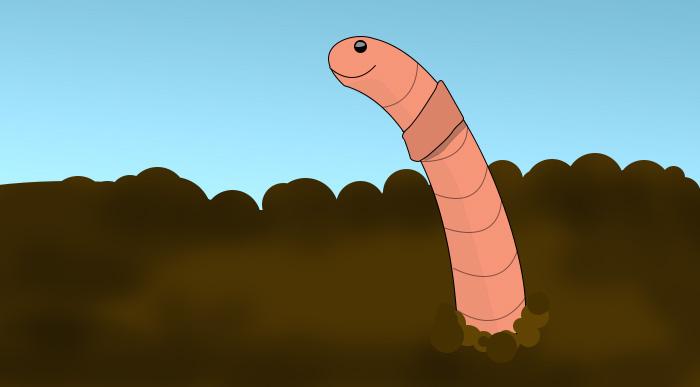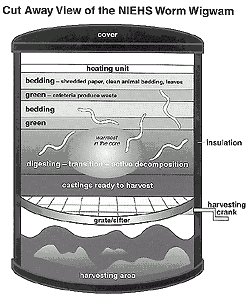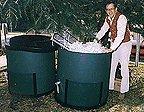NIEHS's 'Worm Wigwams' Welcome Wiggly Waste Watchers
Vermicomposting story from the March 25, 1997 NIH Record
By Doug Nicholas
NIEHS has worms—and they'll even eat broccoli!
Composting is often considered a throwback technology, but the NIEHS environmental awareness advisory committee has taken it on a technological ride into the 21st century by installing North Carolina's first two "Worm Wigwams"—state-of-the-art composting bins that use vermi-technology to turn organic waste into usable mulch in a fraction of the time it normally takes.
What is vermi-technology all about? Simply put, it's about worms. By maintaining suitable temperatures in even the coldest winter months, the Worm Wigwam—with its insulated outside walls and thermostatically controlled electric heater—allows vegetable waste processing red worms to thrive. In return for the comfy home, the red worms process large amounts of organic material, consuming, digesting and passing almost any decaying organic matter including food waste, leaves and grass, shredded paper or cardboard waste, and chopped straw or hay. The worms' castings are the "vermicompost," which is like a rich potting soil but is superior to conventional compost in nutrient levels and water-holding capacity.
Dick Sloane presents former NIEHS Director Dr. Kenneth Olden with a small bag of vermicompost to celebrate the early success of the institute's worm composting project. John Schelp and Laurie Johnson, previous Co-chairs of the Environmental Awareness Advisory Committee, join in the fun. Olden noted that he has been photographed holding many things, but never a bag of worm poop!
The Worm Wigwams cost $375 apiece. Each contains 10 pounds of worms (about 10,000) worth $75, which are working to process 1020 pounds of cafeteria waste plus shredded paper and other organic waste each day. The Worm Wigwam is 3.5 feet tall and 3 feet in diameter. A steel grate separates the processing area where the worms live from the harvest area where the vermicompost falls. A crank on the side of the unit functions like a flour sifter, breaking up the mulch so it can fall through the grate.
A cutaway view shows the inner workings of the Worm Wigwam. Layers of green cafeteria waste and other organic materials are placed on top of a metal grate. Most of the decomposition occurs in the warm core of the pile. The 10,000 worms not only process the waste through digestion, but their constant movement also aerates the organic mass.
Dick Sloane, who spearheaded the effort and set the Worm Wigwams up in early December, said the system offers three benefits. NIEHS reduces its daily waste stream, the compost provides a nutritional mulch for landscaping, and the institute receives a public relations value—people from North Carolina State University in Raleigh and SunShares recycling in Durham have already visited to check out the new composting units.
Dick Sloane shows off one of two Worm Wigwams in use at NIEHS. Attempts to photograph the worms failed due to the critters' shyness; when Sloane opened the lid the worms scrammed to the warm, slimy core of the composting bin.
Compost harvesting began in January, and Sloane conservatively predicts a steady harvest of 2 to 4 cubic feet—about 30 pounds—per week.







